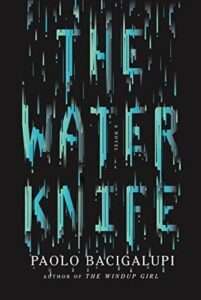 My first thought on finishing this book was, damn. Margaret Atwood is unrelenting in creating a world of fear and oppression. The premise of the novel is what would happen if there were a coup in the United States of America and a religious theocracy based on subjugating women and promoting procreation took over. Sound far-fetched? Take a look at the Quiverfull movement, President Trump’s authoritarian inclinations, the rise of white nationalism and anti-intellectualism. The novel is hauntingly resonant with our present time.
My first thought on finishing this book was, damn. Margaret Atwood is unrelenting in creating a world of fear and oppression. The premise of the novel is what would happen if there were a coup in the United States of America and a religious theocracy based on subjugating women and promoting procreation took over. Sound far-fetched? Take a look at the Quiverfull movement, President Trump’s authoritarian inclinations, the rise of white nationalism and anti-intellectualism. The novel is hauntingly resonant with our present time.
One aspect that works so well in The Handmaid’s Tale is the use of suspense and tension. The reader is slowly figuring out this world. What are the rules? What happened? How does it work? These questions propel the reader along as they drive toward the larger question: what will happen to the narrator? That question looms in the background as the narrator, the Handmaid, is pushed in ways not of her choosing. For in the world of The Handmaid’s Tale, what choice is there for women? One can either be subjugated to the rules of the society, sent to a colony (which is a form of death sentence), or can die. I say, die, because some women take their own lives rather than live in this world, and sometimes they are executed for breaking the law.
What I found intriguing about The Handmaid’s Tale is that it is a novel grounded in feminism. Unlike Brave New World, 1984, Animal Farm, or Fahrenheit 451, which each explore totalitarian dystopias and were all written by men, Margaret Atwood creates a dystopian world that lays bare the fear and tension women feel on a daily basis and an imagined future where women have no rights. In one telling scene, the narrator’s husband says, “I’ll always take care of you.” It’s soon after the changes have begun. The narrator thinks, “Already he’s starting to patronize me.” When I think back to feminist literature I’ve read, The Handmaid’s Tale stands out as a must-read.
Finally, Margaret Atwood, deftly shoots down potential criticisms at the end of the book. By placing the story of The Handmaid’s Tale in a historical context, Atwood uses the arguments academics have made about other cultures and periods. It further places a sense of realism on the book, ties up some loose ends, and serves as a rebuttal for some critics. If you haven’t read The Handmaid’s Tale, I highly recommend it. It’s thought-provoking, wonderfully crafted, and necessary; however, be prepared for a novel that push you into places you’d rather not go. For more on The Handmaid’s Tale, read Margaret Atwood’s essay, “What ‘The Handmaid’s Tale’ Means in the Age of Trump.”



